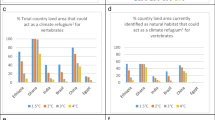Abstract
Effects of climatic factors on plant distribution in the Chubu District, central Japan, were examined with direct gradient analysis. The distribution of many species was controlled not only by temperature but also by snowfall.Sasa kurilensis, Heloniopsis orientalis andTripterospermum japonicum preferred snow regardless of the thermal conditions. The snow seemed to exert more influence on endemics than on the more widespread plants, on evergreen plants more than on deciduous plants, and on trees or shrubs more than on herbs or climbing plants. Thus, the snow factor contributes to the high endemic ratio of central Japan. Among the snow-tolerant evergreen shrubs there were many neo-endemics derived from snow-intolerant parent populations of the species which have restricted distributions in the laurel forests. They could occupy habitats in the summergreen forests, where their life form can withstand heavy snowfall. Because of the heavy snowfall on the Sea of Japan side of central Japan in the postglacial period, evergreen coniferous trees have lost many of their previous habitats since most of them are intolerant of heavy snowfall.
Similar content being viewed by others
References
Austin, M. P., Cunningham, R. B. & Fleming, P. M. 1984. New approaches to direct gradient analysis using environmental scalars and statistical curve-fitting procedures. Vegetatio 55: 11–27.
Braun-Blanquet, J. 1964. Pflanzensoziologie, 3rd ed. Springer, Wien.
Chabot, B. F. & Hicks, D. J. 1982. The ecology of leaf life spans. Annu. Rev. Ecol. Syst. 13: 229–259.
Grime, J. P. 1977. Evidence of the existence of three primary strategies in plants and its relevance to ecological and evolutionary theory. Amer. Nat. 111: 1169–1194.
Hattori, T. & Nakanishi, S. 1985. On the distributional limits of the lucidophyllous forest in the Japanese Archipelago. Bot. Mag. Tokyo 98: 317–333.
Hotta, M. 1974. History and geography of plants. Sanseido, Tokyo.
Hultén, E. 1972. Outline of the history of arctic and boreal biota during the Quarternary period. Wheldon & Wesley, Stechert Hafner service Agency, New York.
Kikuzawa, K. 1984. Leaf survival of woody plants in deciduous broad-leaved forests 2. Small trees and shrubs. Can. J. Bot. 62: 2551–2556.
Kira, T. 1977. A climatological interpretation of Japanese vegetation zones. In: Miyawaki, A. & Tüxen, R. (eds.), Vegetation science and environmental protection, pp. 21–30. Maruzen, Tokyo.
Kira, T. & Yoshino, M. 1967. Distribution of Japanese conifer species along thermal gradients. In: Morishita, M. & Kira, T. (eds), Natural history, pp. 133–161. Chuokoronsha, Tokyo.
Kure, H. & Yoda, K. 1984. The effect of the Japan Sea climate on the abnormal distribution of Japanese beech forests. Jap. J. Ecol. 34: 63–73.
Miyawaki, A. & Itow, S. 1960. Phytosociological approach to the conservation of nature and natural resources in Japan. Divisional Meeting of Conservation, 11th Pac. Sci. Congr. Tokyo.
Miyawaki, A. & Sasaki, Y. 1985. Floristic changes in theCastanopsis cuspidata var.sieboldii-forest communities along the Pacific Ocean coast of the Japanese Islands. Vegetatio 59: 225–234.
Nakaike, T. 1975. Enumeratio pteridophytarum Japonicarum, Filicales. Univ. Tokyo Press. Tokyo.
Ohwi, J. & Kitagawa, M. 1983. Flora of Japan. Shibundo, Tokyo.
Okitsu, S. & Ito, K. 1984. Vegetation dynamics of the Siberian dwarf pine (Pinus pumila Regel) in the Taisetsu mountain range, Hokkaido, Japan. Vegetatio 58: 105–113.
Pianka, E. R. 1970. Onr-andK-selection. Amer. Nat. 104: 592–597.
Sakai, A. 1968. Mechanism of desiccation damage of forest trees in winter. Contr. Inst. Low Temp. Sci., Ser. B. 15: 15–35.
Sakai, A. 1976. Adaptation of plants to deposited snow. Contr. Inst. Low Temp. Sci., Ser. B. 34: 47–76.
Sato, T. 1982. Phenology and wintering capacity of sporophytes and gametophytes of ferns native to northern Japan. Oecologia 55: 53–61.
Tsukada, M. 1983. Vegetation and climate during the last glacial maximum in Japan. Quatern. Res. 19: 212–235.
Whittaker, R. H. 1956. Vegetation of the Great Smoky Mountains. Ecol. Monogr. 26: 1–80.
Whittaker, R. H. 1967. Gradient analysis of vegetation. Biol Rev. 49: 207–264.
Woroschilov, V.N. 1982. Keys to the plants of Soviet Far East. Nauka, Moscow.
Yasuda, Y. 1984. Oscillations of climatic and oceanographic conditions since the last glacial age in Japan. In: Whyte, R. O. (ed.), The evolution of the East Asia environment. Vol. 1. Geology and palaeoclimatology, pp. 397–413. University of Hong Kong.
Yoshie, F. & Kawano, S. 1986. Seasonal changes in photosynthetic characteristics ofPachysandra terminalis (Buxaceae), an evergreen woodland chamaephyta, in the cool temperate regions of Japan. Oecologia 71: 6–11.
Author information
Authors and Affiliations
Rights and permissions
About this article
Cite this article
Uemura, S. Snowcover as a factor controlling the distribution and speciation of forest plants. Vegetatio 82, 127–137 (1989). https://doi.org/10.1007/BF00045026
Accepted:
Issue Date:
DOI: https://doi.org/10.1007/BF00045026




